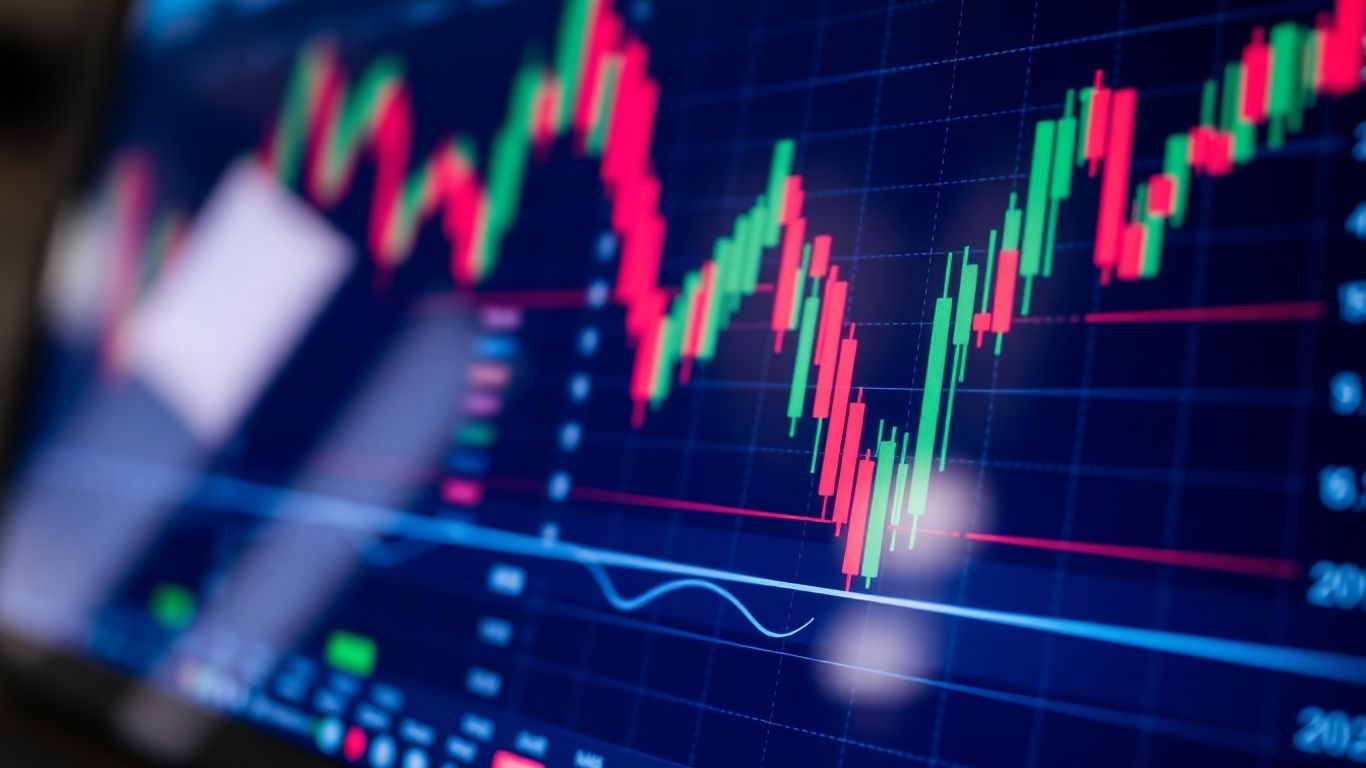Getting a handle on the markets can feel like a puzzle sometimes, right? You see all these charts and indicators, and it's easy to get lost. But what if there was a way to make it simpler, to really see what the big players are doing? That's where a Premium TradingView Strategy comes in. It's like having a special map that shows you the hidden paths and potential pitfalls in the market. We're going to break down how to build and use one so you can trade with more confidence.
Key Takeaways
- Understanding market structure, price action, and core trading ideas is the first step to using a Premium TradingView Strategy effectively.
- Advanced tools like dynamic support/resistance zones, trend detection, and volume analysis help create a more robust trading plan.
- Spotting market shifts, like breaks in structure or changes in character, lets you adapt your Premium TradingView Strategy to current conditions.
- Managing risk with tools like liquidation zones and smart stops is vital for protecting your capital within your Premium TradingView Strategy.
- Customizing your Premium TradingView Strategy with dashboards and alerts, and tailoring it for specific assets like Bitcoin, makes it more practical for your trading style.
Understanding Your Premium TradingView Strategy Foundation
Before you can start making big moves with a premium TradingView strategy, you need to get the basics right. It’s like building a house; you wouldn't start putting up walls without a solid foundation, right? The same applies here. We’re talking about the core ideas that drive how markets move and how you can spot opportunities within that movement.
Defining Core Trading Concepts
At its heart, trading is about buying low and selling high, or vice versa, depending on your position. But what does that really mean in practice? It means understanding the difference between speculation and investment, and knowing your own risk tolerance. Are you looking for quick profits from short-term price swings, or are you aiming for steady growth over months or years?
- Speculation: Betting on short-term price movements, often with higher risk and reward.
- Investment: Holding assets for longer periods, expecting growth based on underlying value.
- Risk Tolerance: How much potential loss you can handle without it affecting your financial well-being.
It’s also about understanding market participants. Who is buying? Who is selling? Why are they doing it? Thinking about these questions helps you see the bigger picture. The market is a constant tug-of-war between buyers and sellers.
Identifying Market Structure Dynamics
Market structure is basically the shape of the price action on your chart. Think of it as the 'story' the price is telling you. Is it going up, down, or just sideways? We look for patterns like higher highs and higher lows (an uptrend) or lower lows and lower highs (a downtrend). Recognizing these patterns is key to figuring out the market's direction.
- Uptrend: Characterized by a series of higher highs and higher lows.
- Downtrend: Marked by a series of lower highs and lower lows.
- Ranging Market: Price moves within a defined horizontal channel, without making significant new highs or lows.
Understanding these dynamics helps you align your trades with the prevailing market direction, which generally increases your chances of success. It’s about working with the market, not against it.
Leveraging Price Action Principles
Price action is the study of price movement over time. It’s about reading the chart without relying too heavily on lagging indicators. You’re looking at the raw data – the candles, the patterns they form, and how price reacts at certain levels. This is where you start to see things like support and resistance zones, which are areas where price has historically had trouble breaking through.
When price approaches a known support level, it might bounce back up. Conversely, when it nears resistance, it might fall back down. These levels aren't always exact lines but rather zones where buying or selling pressure has historically been strong.
By focusing on price action, you can often anticipate market moves before they become obvious to everyone else. It’s about observing how buyers and sellers interact directly on the chart. For example, seeing a strong rejection from a resistance level can be a signal to consider a short position, especially if you've been following price action patterns. This foundational knowledge is what allows you to build a robust trading strategy.
Implementing Advanced Indicators for Premium TradingView Strategy
Alright, so you've got the basics down, and now it's time to really beef up your TradingView strategy. This is where we start layering in some more sophisticated tools to get a clearer picture of what the market's actually doing. We're not just looking at lines on a chart anymore; we're trying to understand the forces behind the price moves.
Utilizing Dynamic Support and Resistance Zones
Forget static lines drawn on your chart. Real support and resistance levels aren't fixed; they shift and change as price moves. Advanced indicators can help identify these dynamic zones. Think of them as areas where price has historically shown a tendency to pause or reverse. These zones are often formed by institutional activity, and by spotting them, you can get a better idea of where potential turning points might be. Some tools can even show you these zones across different timeframes – local, regional, and global – giving you a multi-layered view of potential price action.
Identifying these dynamic zones is key. They aren't just random levels; they represent areas where significant buying or selling pressure has occurred in the past, and where it's likely to occur again. Paying attention to these areas can help you avoid getting caught on the wrong side of a move.
Analyzing Trend and Range Detection
Markets don't always move in clear trends. Sometimes they chop sideways in a range. Being able to tell the difference is pretty important for your strategy. Indicators can help here by tracking the market's bias. Some systems use a multi-tier trailing stop that can filter out a lot of the noise. This helps you stay with a trend when it's strong, but also recognize when the market might be shifting into a range, or if a breakout is happening. It's about adapting your approach based on what the indicators are telling you about the market's current state.
Incorporating Volume and Capital Flow Analysis
Price is only half the story. What about the money moving behind it? Volume and capital flow indicators can give you a look at buyer and seller intent. You'll want to watch for unusual volume spikes – these can sometimes signal big players entering or exiting a position. Cumulative Volume Delta (CVD) and Open Interest (OI) can also be really helpful. CVD shows you the difference between buying and selling volume over time, and OI tells you how many contracts are currently open. Watching these together can reveal shifts in momentum that price alone might not show. This is where you start to see the real money at work, and it can give you an edge in anticipating moves. You can find some great TradingView indicator masterclasses that go into the specifics of setting these up.
Here's a quick look at what you might see:
Mastering Market Shifts with Your Premium TradingView Strategy

Markets are always moving, right? Sometimes they're trending nicely, and other times they're just chopping around. Your premium TradingView strategy needs to be able to handle both. This section is all about spotting when things are changing and what that means for your trades. It’s not just about following the trend; it’s about understanding when the trend might be about to flip or when a breakout is actually real.
Detecting Fractal Market Structure and Shifts
Think of market structure like layers of an onion. You've got the big picture, the medium view, and then the really close-up stuff. These are your fractal levels. A 'Break of Structure' (BoS) happens when price moves past a previous high in an uptrend or a previous low in a downtrend. This usually means the trend is continuing. On the flip side, a 'Change of Character' (CHoCH) is when price breaks a previous low in an uptrend or a previous high in a downtrend. This is often a signal that the trend might be reversing. Spotting these on your charts, especially with tools that highlight them automatically, can give you a heads-up before most traders even notice.
- Break of Structure (BoS): Confirms the existing trend. Price makes a new high (uptrend) or new low (downtrend).
- Change of Character (CHoCH): Signals a potential trend reversal. Price breaks a previous swing low (uptrend) or swing high (downtrend).
- Fractal Levels: Analyzing structure across different timeframes (e.g., short-term, mid-term, long-term) provides a more complete picture.
Understanding Break of Structure and Change of Character
So, we talked about BoS and CHoCH. But how do you know if it's the real deal? Sometimes, price might poke above a resistance level briefly, only to fall back down. That's not a true BoS; it might just be a liquidity grab. Your strategy needs a way to filter these out. Some advanced tools use things like an Average True Range (ATR) buffer to confirm if a break is significant enough to be considered a real structural shift. This helps avoid getting caught in fakeouts. The goal is to confirm genuine shifts in market sentiment.
It's easy to get excited when price breaks a level. But experienced traders know that not all breaks are created equal. Some are just noise, designed to trick you into a bad trade. Learning to differentiate between a true structural shift and a temporary move is key to surviving and thriving in any market.
Validating Breakouts and Liquidity Sweeps
This is where things get really interesting. A liquidity sweep happens when price moves aggressively to a certain level, often to trigger stop-loss orders or fill institutional orders, and then reverses. You might see a big wick on a candle that doesn't result in a sustained move. Your premium TradingView strategy should help you identify these. Look for patterns where price spikes to a key level, triggers stops, and then quickly moves back. This often happens before a real breakout or reversal. Tools that visualize liquidation zones can be super helpful here, showing you where a lot of stop-loss orders might be clustered. If price hits that area and then reverses sharply, it's a strong sign of a liquidity sweep, not necessarily a continuation of the prior move. You can find some great premium indicators that help with this kind of analysis.
Optimizing Risk Management with a Premium TradingView Strategy
Managing risk is probably the most important part of trading, right? It's what keeps you in the game. With a premium TradingView strategy, you get tools that help you see where the danger zones are and how to stay safe. We're talking about making sure you don't lose more than you can afford, even when the market gets wild.
Visualizing Liquidation Risk Zones
Ever wonder where the big players might get forced out of their positions? Liquidation zones are basically price levels where a significant number of traders using leverage might have their positions automatically closed by the exchange. Seeing these areas on your chart is super helpful. It's like having a heads-up about potential volatility spikes or areas where price might suddenly accelerate because of forced selling or buying.
- Identify High-Leverage Areas: These are spots where traders are using a lot of borrowed money, making them more vulnerable.
- Spot Potential Price Magnets: Sometimes, price can get drawn to these zones before a big move.
- Plan Entries/Exits: Knowing these zones can help you set your stop losses or take-profit orders more strategically.
Think of it like this: you're walking through a forest, and you can see areas where there might be quicksand. You wouldn't just charge through them, right? You'd find a way around or be extra careful. Liquidation zones are kind of like that quicksand for traders.
Understanding where liquidations are likely to occur can give you a significant edge. It's not just about predicting price direction, but also about anticipating the forces that can cause rapid price movements.
Implementing Smart Trailing Stops
A regular stop-loss is fine, but a trailing stop is where it's at for protecting profits while letting your winners run. This type of stop moves with the price as it goes in your favor, locking in gains. If the price reverses, the trailing stop stays put, protecting your accumulated profit. It's a dynamic way to manage your risk without you having to constantly watch the charts.
Here’s how they work in practice:
- Set Initial Stop: You define an initial stop-loss level, just like usual.
- Define Trail Amount: You set a distance (either a fixed amount or a percentage) that the stop will trail behind the highest price reached since your trade went profitable.
- Automatic Adjustment: As the price moves up (for a long trade) or down (for a short trade), your stop-loss automatically adjusts to stay that set distance behind the peak price.
This method is great because it helps you capture bigger moves while automatically taking some profit off the table if the trend reverses unexpectedly. It's a key part of a premium AI-powered TradingView strategy.
Managing Position Risk Across Structures
Markets aren't just one big blob; they have different structures – like trends, ranges, and consolidation periods. Your risk management needs to adapt to these different environments. A position that's fine in a strong trend might be too risky in choppy, sideways action. Premium TradingView strategies help you identify these structures so you can adjust your position size and stop-loss distances accordingly.
By adjusting your risk based on the market's current behavior, you're not just trading; you're actively protecting your capital. It’s about being smart and adaptable, not just guessing.
Enhancing Your Premium TradingView Strategy with Dashboards and Alerts
Alright, so you've got your premium TradingView strategy dialed in, but how do you keep tabs on everything without staring at the screen all day? That's where dashboards and alerts come in. They're like your personal trading assistants, keeping you in the loop without demanding constant attention.
Leveraging Trend Snapshot Dashboards
Think of a trend snapshot dashboard as a quick overview of what the market's doing right now. It’s not about every single tick, but the bigger picture. You can set these up to show you things like the current trend strength, the general direction of capital flow, and maybe some key activity from the last few swings. It’s super handy for getting a feel for the market's mood at a glance. You can even get these dashboards to work on your phone, which is pretty neat when you're on the go. It helps you stay aligned with the main market flow, which is pretty important if you ask me.
Configuring Proximity Alerts
Proximity alerts are all about giving you a heads-up when price is getting close to a level that matters. This could be a support or resistance zone, or maybe a level where you expect a certain market reaction. You can tweak these alerts to be more or less sensitive depending on your trading style. For instance, if you're scalping, you might want alerts to trigger when price is really close to your target. If you're a swing trader, you might give it a bit more room. It's about setting up those boundaries so you don't miss opportunities or get caught off guard. You can adjust these for different structural levels, like local, regional, or even global ones, giving you a lot of control.
Interpreting Market Structure Alerts
These alerts are more about the actual mechanics of the market. They can notify you when there's a break of structure (BoS) or a change of character (CHoCH). These are big signals that the market's trend might be shifting. Getting an alert for these events means you can react faster, whether it's to adjust your current trades or look for new opportunities. It's like having a system that tells you, 'Hey, something significant just happened here!' This helps you stay on the right side of potential moves. You can even get alerts for things like potential liquidity grabs, which is pretty advanced stuff.
Setting up effective dashboards and alerts isn't just about convenience; it's about building a more responsive trading system. It allows you to react to market changes more quickly and with greater confidence, especially when dealing with complex market structures. Think of it as automating your awareness, so you're always informed without being overwhelmed.
Here's a quick look at what you might want to monitor:
- Trend Strength: Is the current trend strong, weak, or is the market just chopping sideways?
- Directional Flow: Which way is money generally moving? This can be seen through price action, open interest, or cumulative volume delta.
- Key Levels: Are we approaching significant support, resistance, or liquidity zones?
- Structural Shifts: Has there been a confirmed break of structure or change of character?
These tools, when used correctly, can really help you stay on top of your game. They’re part of what makes a premium strategy truly work in the real world, not just on paper. You can find some really advanced tools that help with this, like the TradingView Indicator Suite which offers a lot of these features.
Tailoring Your Premium TradingView Strategy for Specific Assets

So, you've got your premium TradingView strategy dialed in, but is it a one-size-fits-all kind of deal? Not quite. Different markets, like Bitcoin versus, say, a less volatile altcoin, behave in their own unique ways. You can't just slap the same settings on everything and expect magic. It’s like trying to use a hammer for every single job – sometimes you need a screwdriver, right?
Bitcoin Trading Strategy Insights
Bitcoin is its own beast. It’s known for those wild swings and can move on news faster than you can blink. When you're charting Bitcoin, you'll want to pay close attention to its long-term trends. Using a daily or even weekly chart can give you a better picture of the bigger moves. Tools that help detect major support and resistance zones are super useful here, as these levels often act as magnets for price. We're talking about areas where institutions might be looking to step in. Remember, Bitcoin's price action can be heavily influenced by market sentiment and global economic events, so keeping an eye on broader financial news is also smart.
Cryptocurrency Asset Analysis
Beyond Bitcoin, the crypto space is a whole different ballgame. You've got everything from established coins to brand-new tokens, each with its own volatility and trading volume. For smaller cap coins, you might see even more dramatic price action, but also higher risk. It’s important to adjust your indicators and timeframes. For instance, a strategy that works for Bitcoin might be too slow for a fast-moving altcoin. You might need to look at shorter timeframes and indicators that can pick up on quicker shifts in momentum. Analyzing volume and capital flow becomes even more critical here, as it can show you where the real money is moving. Some traders find that using a custom indicator can provide specific insights for these diverse assets.
Adapting Strategies for Different Markets
Think about it: a strategy that works for forex might not translate directly to commodities, and definitely not to crypto. Each market has its own rhythm, its own drivers. For example, in traditional markets, you might focus more on economic data releases. In crypto, it's often about technological updates, regulatory news, or even social media trends. You need to be flexible. This means tweaking your indicator settings, adjusting your risk management rules, and maybe even changing the types of patterns you look for. It’s about being observant and willing to adapt your approach based on what the market is telling you.
The key is not to be rigid. Markets evolve, and your strategy needs to evolve with them. What worked last month might not work today. Stay curious, keep testing, and don't be afraid to experiment with different settings and indicators to find what clicks for each specific asset you're trading.
Putting It All Together
So, we've walked through how to use TradingView and some of the tools that can help you trade better. Remember, no strategy is perfect, and the market always changes. The key is to keep learning and adapting. Use what we've discussed to build your own approach, test it out, and see what works for you. Don't expect to become a master overnight; it takes practice and patience. But with the right tools and a solid plan, you can definitely improve your trading game. Good luck out there.
Frequently Asked Questions
What is a 'Premium TradingView Strategy'?
Think of a 'Premium TradingView Strategy' as a special set of rules and tools you use on TradingView to help you make smart decisions when buying or selling things like stocks or cryptocurrencies. It's like having a super-powered map and compass for navigating the financial markets, going beyond the basics to find better opportunities.
How do I know if a trading strategy is 'good' for me?
A good strategy fits your personality and goals. If you like quick trades, a fast strategy might work. If you prefer to wait for bigger moves, a slower strategy is better. It's also important that the strategy helps you understand why you're making a trade and how to protect your money if things go wrong.
What are 'Market Structure Dynamics' and why do they matter?
Market structure is like the shape or pattern of the market's price movements over time. Understanding these patterns helps you see if the market is generally going up, down, or sideways. Knowing this is super important because it helps you guess where prices might go next.
Can I use these strategies for any type of investment?
Yes, many of these ideas can be used for different things you can trade, like stocks, currencies, or even digital money like Bitcoin. However, some strategies might work better for certain types of investments than others, so it's good to learn which ones are best for what you're trading.
What's the difference between a 'Break of Structure' and a 'Change of Character'?
Imagine the market is climbing a staircase. A 'Break of Structure' is like taking another step up, showing the climb is continuing. A 'Change of Character' is like the market suddenly changing direction, maybe starting to go down after going up. It signals a possible big shift.
How do 'Liquidation Risk Zones' help me manage my money?
'Liquidation Risk Zones' show you where the market might suddenly 'liquidate' or force-close trades, especially when people use borrowed money (leverage). Knowing these zones helps you avoid being caught in those sudden moves and protect your investment from big losses.










